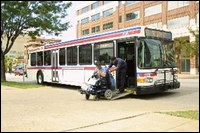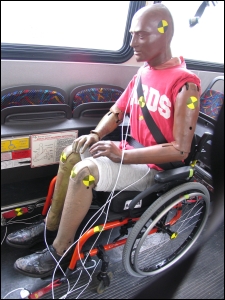Wheelchair Transportation: Safety & Accessibility
In-depth Assessment of Wheelchair Ramp Activities and Incidents on Public Transit Buses
funded by NIDRR Field-Initiated Research (Grant #H133G110074)

Assessment of Wheelchair Related Activities in Paratransit Vehicles
funded by NIDRR Field-Initiated Research (Grant #H133G130166)
The experience of traveling in a paratransit vehicle while seated in a wheelchair differs substantially from the experience of traveling in a public transit bus while seated in a wheelchair. In contrast to large, public transit buses, paratransit vehicles will experience a higher crash severity for a given event due to lower vehicle mass. Wheelchair lifts are the predominant means of boarding paratransit vehicles due to the higher vehicle floor of full-size vans and mini-buses. Studies of injuries experienced by wheelchair passengers on paratransit vehicles indicate that incidents occur most often during transit, followed by incidents that occur during lift usage.
The goal of this st udy is to gain insight into wheelchair-related activities on paratransit vehicles in order to improve transportation safety for both passengers and paratransit vehicle operators. Two paratransit vehicles will be outfitted with cameras viewing the lift and multiple angles inside the vehicle. Recorded videos will be watched, with each trip by a wheelchair-seated passenger analyzed and detailed information about ingress/egress, Wheelchair Tiedown and Occupant Restraint System (WTORS) usage, maneuvering to/from securement stations, and wheelchair stability during transit entered into a database. This information will be used to characterize the experiences of wheelchair seated passengers on paratransit vehicles. Incidents taking place at any point during these processes will be logged and described in the database, with factors contributing to these incidents identified.
udy is to gain insight into wheelchair-related activities on paratransit vehicles in order to improve transportation safety for both passengers and paratransit vehicle operators. Two paratransit vehicles will be outfitted with cameras viewing the lift and multiple angles inside the vehicle. Recorded videos will be watched, with each trip by a wheelchair-seated passenger analyzed and detailed information about ingress/egress, Wheelchair Tiedown and Occupant Restraint System (WTORS) usage, maneuvering to/from securement stations, and wheelchair stability during transit entered into a database. This information will be used to characterize the experiences of wheelchair seated passengers on paratransit vehicles. Incidents taking place at any point during these processes will be logged and described in the database, with factors contributing to these incidents identified.
Concurrently, the weight carried by lifts on paratransit vehicles will be characterized. The wheelchair lift on one paratransit vehicle will be outfitted with a load cell that will measure the weight carried by the lift. The measured weights carried on the lift will be compared to design standards for wheelchair lifts, with these design standards evaluated regarding their relevance to the actual wheelchair user population.
The outcomes of this study will allow us to better understand the experiences of wheelchair users on paratransit vehicles, the use, misuse, and disuse of WTORS, and the frequency and contributing factors of incidents wheelchair seated passengers encounter. They will allow us to inform wheelchair users of the experiences and risks they are likely to face when using paratransit vehicles, make recommendations regarding safety policies and practices of vehicle operators, and make recommendations regarding design guidelines of wheelchair lifts, WTORS systems, and other vehicle components.
Consequences of Wheelchair Tiedown and Occupant Restraint System Practices on Wheelchair Passenger Safety in Fixed-Route Transit
funded by NIDRR Switzer Fellowship (Grant #H133F100032)
 Many wheelchair users rely upon fixed-route public transportation using large accessible transit vehicles (LATVs) for independent transportation to and from work, healthcare appointments and leisure activities, and a substantial number of these wheelchair users may not be able to transfer from their wheelchair to a motor vehicle seat during transit. It is necessary to afford these wheelchair users the same level of safety as occupants seated in motor vehicle seats. Therefore, the Americans with Disabilities Act (ADA) requires that LATVs be equipped with wheelchair securement and occupant restraint systems (WTORS). The four-point tiedowns and occupant restraints are the primary means of WTORS on LATVs. Recent research has shown extremely high disuse and misuse rates for this WTORS. However, to date, no studies have investigated the underlying causes of WTORS misuse and disuse. Perhaps more importantly, the consequences of WTORS misuse and disuse for wheelchair passengers aboard LATVs have not been determined. This study consists of three major phases aimed at describing consequences of WTORS misuse and disuse for wheelchair passengers on LATVs:
Many wheelchair users rely upon fixed-route public transportation using large accessible transit vehicles (LATVs) for independent transportation to and from work, healthcare appointments and leisure activities, and a substantial number of these wheelchair users may not be able to transfer from their wheelchair to a motor vehicle seat during transit. It is necessary to afford these wheelchair users the same level of safety as occupants seated in motor vehicle seats. Therefore, the Americans with Disabilities Act (ADA) requires that LATVs be equipped with wheelchair securement and occupant restraint systems (WTORS). The four-point tiedowns and occupant restraints are the primary means of WTORS on LATVs. Recent research has shown extremely high disuse and misuse rates for this WTORS. However, to date, no studies have investigated the underlying causes of WTORS misuse and disuse. Perhaps more importantly, the consequences of WTORS misuse and disuse for wheelchair passengers aboard LATVs have not been determined. This study consists of three major phases aimed at describing consequences of WTORS misuse and disuse for wheelchair passengers on LATVs:
Phase 1 - A case series of adverse events involving wheelchair-seated passengers on LATVs
Phase 2 - Driving experiments using a wheelchair-seated anthropomorphic testing device onboard a LATV
Phase 3 - Development, validation, and verification of a computer simulation of a wheelchair passenger onboard a LATV
Using the model, a parametric sensitivity analysis would provide an opportunity to investigate the influence of various model parameters on wheelchair and passenger outcomes. This study aims to identify consequences of WTORS disuse and misuse, and should provide the rationale for new transit agency policies regarding wheelchair transportation safety.
Assessment and Monitoring of Wheelchair Transportation Activities and Incidents on Public Buses
funded by NIDRR Rehabilitation Engineering Research Center (RERC) on Wheelchair Transportation Safety (www.rercwts.org)
Wheelchair users must often rely upon public transportation to access work, medical care, school, and social activities. In the public transit setting, there is evidence of wheelchair-seated passengers sustaining serious injuries during normal and emergency driving maneuvers, as well as during ingress/egress. However, little is known regarding factors and conditions that lead to these injuries. A more complete and objective understanding of wheelchair transportation issues in the transit environment is needed for improvement in operator training, operational procedures, wheelchair designs, and adaptive equipment (lifts/ramps, wheelchair tiedowns and occupant restraint systems) designs that will ultimately result in improved safety, usability and independence for wheelchair-seated passengers traveling in buses. This project will provide an understanding of adverse incidents, injury scenarios and activities (ingress/egress, securement and occupant restraint process, navigating to securement station) on large transit buses involving wheelchair-seated passengers using both a retrospective and innovative prospective approach. This project is possible due to a unique collaboration with the Transit Authority of River City (TARC), which includes unlimited access to their in-bus video surveillance system. Results of this project will provide an objective window into real-world wheelchair-seated passenger experiences on transit buses traveling in a large metropolitan region.
